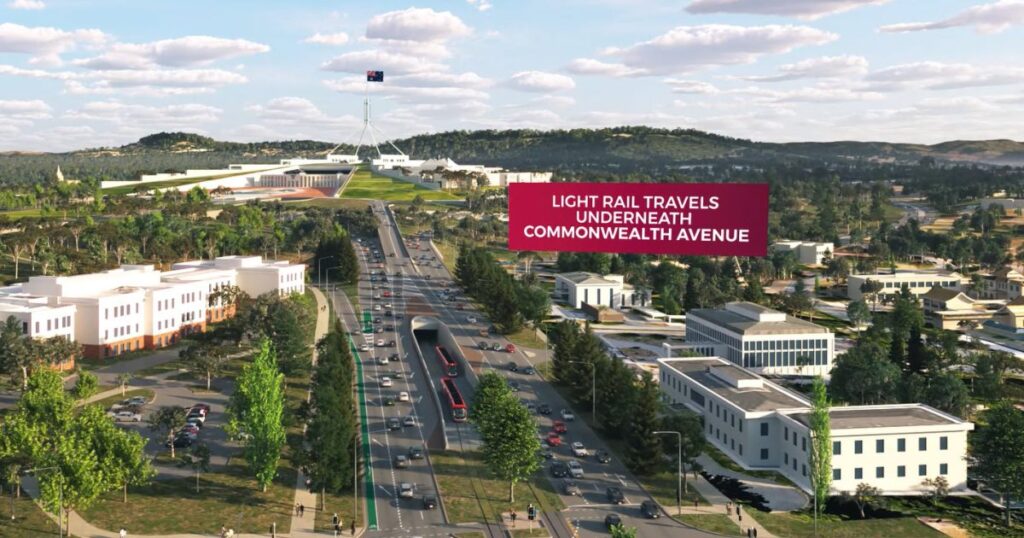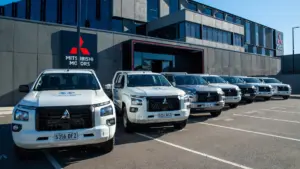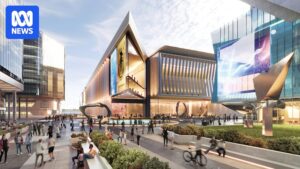
In a bold proposal that challenges Canberra’s current light rail plans, Jack Kershaw, former president of Canberra Community Action on Acton Inc and The Residents Rally for Canberra Inc, has submitted an alternative route for the light rail stage 2B’s draft Environmental Impact Statement (EIS). Kershaw argues that his proposed route offers “more respect, panache, and verve” than the existing options, advocating for a path that avoids the Commonwealth Avenue Bridge and instead traverses the Acton foreshore, crossing Lake Burley Griffin from the National Museum of Australia.
Kershaw, an architect, describes his design as more respectful of heritage while being uplifting and inclusive. He asserts that it would be “simpler and quicker to build, with improved benefits for the ACT, the Capital and the nation, as well as for national attractions, institutions, offices and business, and for workers, shoppers, students, visitors and residents, the environment and the economy.”
The Proposed Route and Its Implications
The proposed route by Kershaw would divert from Commonwealth Avenue into the Acton Waterfront and park precinct, following Lawson Crescent alongside the Australian National University (ANU) South. It would link with the National Museum and the Australian Institute of Aboriginal and Torres Strait Islander Studies before reaching the southern shore of Acton Peninsula. A new, elegant bridge would then span the lake, offering passengers spectacular views.
“Passengers crossing the lake on the government’s proposed new bridge, inserted between the two existing carriageways, would shamefully have their views of the lake largely impeded,” Kershaw criticized.
Kershaw’s design also suggests avoiding State Circle North due to its complexity and cost, arguing it does not adequately serve the Parliamentary Triangle or the growing precinct of Barton. Instead, he proposes a route passing south of Old Parliament House, with a tram stop near Queen Victoria Terrace, and then directly across Kings Avenue to National Circuit in Barton.
Community Reaction and Government Response
The proposal has sparked a mix of reactions within the community. While some support the preservation of Commonwealth Avenue and its iconic bridge, others are concerned about the feasibility and potential delays of adopting a new route. Infrastructure Canberra has welcomed feedback on the draft EIS but cautioned that any deviation from the National Capital Plan could introduce planning and delivery risks.
“Any departure from the National Capital Plan could introduce planning and delivery risks, including the need for amendments and additional Commonwealth approvals,” a spokesperson for Infrastructure Canberra noted.
Despite these challenges, Kershaw remains optimistic, suggesting that the current public comment period might provide an opportunity to revisit the route. He insists that his alternative plan could save Commonwealth Avenue and its bridge while setting a preservation precedent for Kings Avenue.
Historical Context and Expert Opinions
The debate over Canberra’s light rail routes is not new. The city’s transport infrastructure has long been a topic of discussion, balancing modern needs with the preservation of its historical and cultural landscapes. Experts in urban planning and heritage conservation have often weighed in on such matters, emphasizing the importance of integrating new developments with existing urban fabric.
Dr. Lisa Roberts, an urban planning expert, commented on the situation, “Canberra’s unique layout and heritage require careful consideration in any infrastructural development. While innovation is necessary, it should not come at the expense of the city’s historical identity.”
Looking Ahead: The Future of Canberra’s Light Rail
As the debate continues, the future of Canberra’s light rail remains uncertain. The ACT Government’s preferred route, which includes crossing the Commonwealth Avenue Bridge and using State Circle East, was selected after extensive analysis and consultation. It is supported by the National Capital Authority for its balance of transport outcomes, heritage values, and technical feasibility.
“The ACT Government’s preferred route – across Commonwealth Avenue Bridge and via State Circle East – was selected after extensive analysis and consultation, and is supported by the National Capital Authority,” the Infrastructure Canberra spokesperson reiterated.
For now, the community awaits the outcome of the public consultation process, which will determine whether Kershaw’s proposal gains traction or if the current plans proceed. The decision will have lasting implications for Canberra’s urban landscape and its residents.







